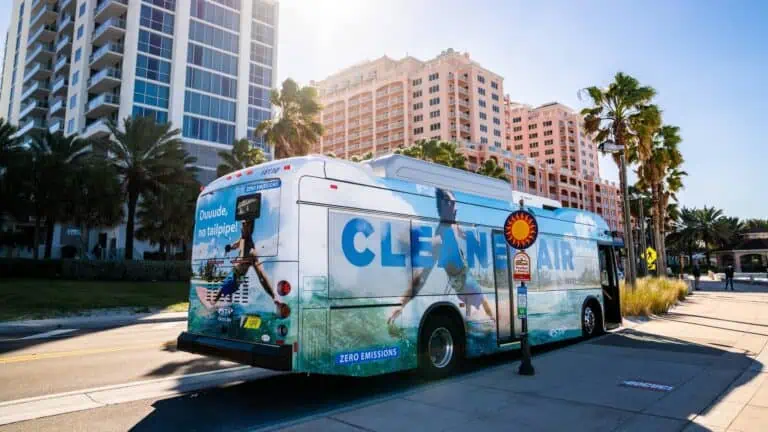One of St. Petersburg’s most influential companies celebrates 125 years in the Sunshine City this summer, and its roots go back even farther than that. The St. Petersburg Electric Light and Power Company, known today as Duke Energy Florida, received its state charter on July 18, 1899, but the lights first turned on in St. Petersburg almost two years earlier, on August 5, 1897.
It was all the vision of a man named Frank Allston Davis, a Vermont farmboy who’d gone on to build a successful publishing company in Philadelphia in the 1880s . The F.A. Davis Company made a name for itself printing medical journals and bulletins, and is still a successful family-owned business today, run by descendants of Frank A. Davis.
Light and Power Company.
In the 1890s Davis suffered a bout of muscular rheumatism, which was exacerbated by the cold Philadelphia winters. Having heard of the healing benefits of Florida’s balmy climate from his many medical connections, Davis spent the winter of 1890 in Tarpon Springs and felt better by the end of the season. Awed by the incredible turnaround in his health, Davis recognized the potential of Pinellas County as a winter resort destination. The peninsula just needed infrastructure, which Davis was willing to provide with funds invested by fellow Philadelphian Jacob Disston. With Disston’s money, Davis built an electric plant, powered by a 50 watt dynamo, but residents of Tarpon Springs seemed curiously indifferent to the powers of electricity, content to continue lighting their streets and homes with kerosene; the city refused to grant Davis a satisfactory franchise for the power company.
So Davis packed his small power plant onto a horse and cart and hauled it down to the waterfront of the small town of St. Petersburg, founded less than ten years before, in 1888. The lights flickered on for the first time on August 5, 1897. Despite the power plant’s rickety appearance (one company official later called the wooden shack, steam boiler, and 50-watt dynamo a “wonderful collection of junk”), citizens were thrilled with the thirty incandescent streetlights and two arc lights that lit the streets from dusk to midnight. They marked the occasion with a day-long celebration featuring a bicycle race, baseball game, fireworks, and a grand ball at the Detroit Hotel on Central Avenue and 2nd Street. There was a feeling that the small town of St. Petersburg had arrived.
Davis would spend the rest of his life trying to ensure that the city really had arrived. He quickly set out to further improve St. Petersburg, opening the electric trolley line and a steamship company and building an “electric” Pier at the foot of 2nd Avenue North to help boost the city’s shipping and recreational possibilities. To ensure there were people to use his newly created electricity and trolleys, Davis published thousands of copies of the very article that had convinced him to try the Florida remedy in the first place: Dr. C. Vann Bibber’s 1885 paper to the American Medical Association declaring Point Pinellas as the healthiest spot in America. The medical journals in which Davis promoted St. Petersburg landed in the offices of doctors throughout the country, attracting visitors in droves. More were lured by the beautiful photo booklets that Davis published, like Souvenir of St. Petersburg: Pleasure City of the South.
Davis’ boosterism worked. By 1900 the city’s population had grown from 273 people to 1,500 people. By 1910 there were more than 4,000 residents and St. Petersburg Light and Power Company was providing all night service to its customers. By 1920, 14,000 people were calling St. Petersburg home. The small waterfront plant couldn’t generate the supply needed in a town of that size, so a new plant was built at 16th Street and 1st Avenue North, and then another at Bayboro Harbor in 1924 (that building, minus the tell-tale smoke stacks that once marked it as a power plant, is still standing today.) St. Petersburg had most definitely arrived.
First Avenue in the 1920s.
As its customer base grew, St. Petersburg Light and Power Company changed its name to the Florida Power Corporation in 1927 and built a stately brick headquarters at 5th Street and 1st Avenue South (that building was demolished in the 1970s.) The company was ready for the tremendous population boom of the 1920s, when St. Petersburg’s population grew from 14,000 people to 40,000 people, with double that number in the winter. Frank Davis wouldn’t be there to see it, having died in 1917, never quite knowing that the fledgling company he built in a town of less than 300 people would grow into one of the most influential companies to ever call the city home.
The boom of the 1920s was nothing compared to what the Florida Power Corporation, the city, and the entire state would experience following World War II.
Read Part Two of 125 Years of Light and Power, and Part Three.
Photos courtesy of the St. Petersburg Museum of History, Tampa-Hillsborough County Public Libraries, the Florida State Archives, and the Library of Congress.
ADVERTISEMENT































